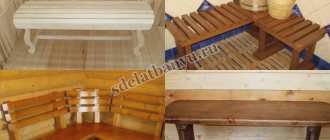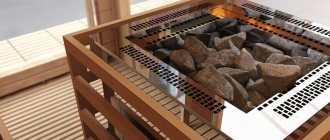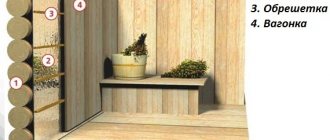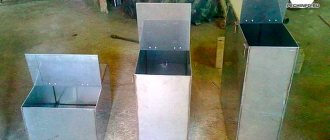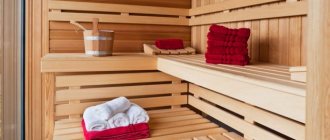There is a lot of confusion about bath furniture. Everything is thrown into one pile - benches, benches, shelves, deck chairs. Yes, of course, if we proceed from the logic “this is a chair, they sit on it, this is a table, they eat at it,” then we can simultaneously describe all the seats in the bathhouse as such a conditional one type. However, we believe that a bench, a bench and a shelf are different things that require different descriptions.
Therefore, on our website various materials are devoted to them. Let's clarify. Bench
can stand anywhere, including along the wall,
the bench can always be placed along the wall, perhaps even with a fastening on it. Shelves are places for sitting and lying in the steam room.
In this material we will talk exclusively about the first type of bath furniture.
Variety of designs and requirements for them
The word “bench” often serves as a collective name, although in any bathhouse, strictly speaking, there are three types of structures. They have a lot in common, although there are differences:
- Bench . A bench in a bathhouse usually means a portable seat (although there are both portable and stationary options).
- Bench . A seat with or without a backrest, but then adjacent or attached to the wall. A bench, as a rule, is a stationary object.
- Shelf (or sun lounger) . A seat or lounger with strictly defined dimensions is installed exclusively in the steam room. The design of the shelves (emphasis on the last syllable) is extremely varied. There are stationary, removable options, as well as their varieties: tiered, folding, folding.
The terminology is not strict: a bench can be used as a shelf in a steam room. However, no matter what the bathhouse bench is, there is a set of requirements that are the same for all bathhouse furniture. One of the main ones is safety and the associated sustainability.
Bench and benches in the recreation area Source homeli.ru
To prevent a person sitting on the edge of a bench from turning over with it, the structure must have the correct proportions, be low enough, and have a comfortable wide seat to distribute the weight. The weight of the product also plays a big role in stability. In addition to safety, the following qualities are important:
- Two interrelated qualities: functionality and convenience . The size of the furniture plays a big role here.
- When creating bath benches and sun loungers, design is not important : traditional simplicity of forms is welcome.
- Reliability . A lot depends on the design here. For example, a bench in the form of a board with two supports will quickly sway under the weight of those sitting and fall apart. The structure must be strengthened with the help of spacers between the legs, installation of additional (intermediate supports), and braces.
- Durability . You should not use too massive boards to make bath furniture: they absorb more moisture, take longer to dry, and are more difficult to dry properly.
Corner bench in the washing room Source dekoriko.ru
What items should a bath furniture set consist of?
You need to focus on individual tastes and financial capabilities, but there is a certain standard minimum.
- Shelves must be made in the steam room of the bath. They can have different shapes and sizes: single-stage or have several steps; located along the walls of the bathhouse or be in the shape of “G”, “P”. Wooden headrests and footrests are often placed in the steam room. Due to the fact that the place where they steam is small, it does not need to be cluttered with unnecessary objects, as they will serve as an obstacle to the movement of air. For convenience, you can add a small bench to place basins and ladles and attach hooks.
Shelves are the most important component of a bathhouse interior and making them yourself is absolutely simple and inexpensive.
Types and shapes of shelves for baths
- The washing compartment of the bathhouse should be equipped with a shelf, and benches of various configurations and sizes can be made.
Details such as stools for tubs, buckets and other bath utensils would be useful here. Place a hanger away from possible splashes. Scheme and drawing of a bench for a wooden bath
Ergonomics of bath furniture: optimal sizes
The size of benches and other furniture affects the comfort of bath procedures. Sitting on a bench that is either too low or too high is equally uncomfortable, which must be taken into account when purchasing (or making) furniture. When choosing the size of a bench for a bathhouse, much depends on the area of the premises, but, for example, the height of the seat, a key parameter for convenience, does not depend on the dimensions of the steam room.
When choosing the size of bath furniture, many owners are guided by the size of regular visitors to the bathhouse. But, if the “users” are of normal height, you can take the average shop sizes with the following values:
- For sitting . The optimal height would be 50-80 cm, width - at least 40 cm. An additional element is a footrest.
- For the sauna . They are traditionally made a little taller, 50-90 cm, and wide, 40-50 cm, so that you can sit half-sitting. It is logical that the element of furniture is a fairly high back, from 100-110 cm.
- For lying down . The average height is 50 cm, width is at least 90 cm. A footrest is not needed for this design.
The upper tier is often made wider Source vsyakraska.ru
- Length . A bench intended for one has a length of approximately 90 cm. A seat for two will be 60 cm longer, for three – 120 cm.
- Seat features . It is necessary to leave gaps of 1-1.5 cm in the seat between the boards. Thanks to the gaps, water will drain faster from the wooden surface and it will dry faster.
Do-it-yourself bathhouse benches: photo
Benches in a bathhouse are utilitarian “furniture” and do not offer much variety in design. However, such products can be given individuality. For example, for a seat you can use a non-standard flooring made of slats, and a cut from the trunk. This is a very effective option for a Russian bath.
It is prohibited to paint bench boards. However, the use of colored impregnations allows you to diversify the design.
In classic benches, the seats are arranged lengthwise. This is a standard do-it-yourself bathhouse bench design, which can be seen in many photos.
It is also possible to arrange the bench slats in the bathhouse across. In this case, the bar for the bench is chosen to be narrow - 5 cm.
If the seat must be level, then this requirement does not apply to the rest of the upholstery of the sunbeds and the backrests. Benches with decorative elements look more interesting.
The most impressive bathhouse benches are those with colored lighting, and they are attractive not only in photos, but also in person.
The choice of design should take into account the overall style of the bathhouse. Backlighting, for example, is not the best option for a rustic-style bathhouse.
Types and quantities
Furniture for different bath rooms differs in parameters and appearance. Thus, benches for the washing department have the following features:
- The simplest and at the same time stable model, capable of supporting the weight of not only a person, but also a container of water. It shouldn't tip over if you sit on the edge.
- For production, wood species that are resistant to contact with water and high air humidity are selected.
- For safety, the supports are moved to the edges of the structure, the boards chosen are thick enough, from 4 cm.
- The natural location is along the walls, near shelves for bath accessories.
Furniture intended for the rest room is more comfortable:
- Typically, wooden benches have a backrest and can be moved.
Two-tier design for a steam room with an additional shelf Source ytimg.com
- Any wood, even soft wood, is chosen for production, since air humidity is close to normal.
- The surface of the material needs careful processing, and the products themselves can be decorated.
The optimal number of benches for a bathhouse is determined based on the number of visitors to the bathhouse. It is important to arrange them so that they allow free movement around the room. To solve the problem, it is convenient to make a drawing with preserved proportions.
In a small bathhouse in the washing room, as a rule, two benches are placed; they are designed for one and two visitors. In the relaxation room, the furniture is placed around the table and has large dimensions so that you can lie down.
See also: Catalog of companies that specialize in the design and construction of baths of any complexity
Means of protection
Many people believe that it is only necessary to protect the wood of a bench if it is not in a steam room. In fact, it is in the steam room that the tree needs protection most of all, but previously we had to abandon this idea, because at high temperatures any chemical tends to become volatile and poison the air that those steaming breathe.
But progress is progress - the Finns have plenty of compounds that are suitable even for their hot sauna , not to mention the much “cooler” Russian bath. Such impregnations can protect wood from water, darkening, rot, etc. In this case, the surface will not feel greasy to the touch.
IMPORTANT! Varnishes should not be used in a steam room - this is a fact.
But in all other rooms, except for the steam room, you are completely free to use any compositions that can protect the wood from the action of water, bacteria, fungi, insects and rodents. If desired, you can also coat it with fire retardants - compounds that make the wood non-flammable.
Why it is necessary to protect wood in a washing room - it’s clear, water flows there. But the rest of the bath rooms are not entirely dry either. Be that as it may, the humidity in the bathhouse is high everywhere. So saturate and varnish with whatever you see fit.
Requirements for material and homemade structures
All bath furniture is made of wood, which is not surprising, given the naturalness and environmental friendliness of the material. However, there are some requirements that wood intended for use in specific conditions must meet.
One of the options for a mobile bench Source mebpilot.ru
When evaluating different types of wood, pay attention to how well they correspond to the following parameters:
- Moisture resistance . For the bathhouse, choose breeds that are least susceptible to any type of humidity, and therefore resistant to the appearance of fungus and rot. Moisture resistance is explained by the presence of special resinous substances; They extend the life of the furniture.
- High density . Dense wood is more suitable for a bathhouse, as it is less susceptible to cracking due to temperature changes. A crack is the result of wood breaking along the grain, caused, for example, by uneven drying. Cracks in bath furniture are extremely undesirable, as they are dangerous due to splinters.
- Low thermal conductivity . The parameter depends on the density, humidity and direction of the fibers. Thermal conductivity along the wood fibers is almost three times higher than across it. This can be taken into account when choosing a material: the lower the thermal conductivity, the less the surface heats up and the less discomfort from touch.
- Durability . The boards should be free of knots, chips and other defects. All of them contribute to a decrease in strength.
Processing the edge of the seat Source pinimg.com
Homemade wooden structures must meet the following requirements:
- The surface of the material is carefully leveled by grinding. To do this, use manual sanding (with sandpaper with sequential changes in grain size) or a grinding machine.
- The corners of the furniture must be rounded, since radius parts are safer.
- Stability is important for all objects, even with uneven load; a margin of safety is also required.
- The space under the bathhouse benches is not sewn up; this helps the wood dry out faster. For the same purpose, a gap of 7-10 cm is left between the object and the wall.
- Furniture is placed only against blank walls so that those sitting do not get caught in a draft.
- It is prohibited to use paints and varnishes for surface treatment; when heated, they release dangerous volatile compounds. There will be an unpleasant smell in the room, and such a procedure will have very little to do with health.
- Naturally based antiseptic impregnations (vegetable oils, wax) are allowed.
Natural oil for shelves in baths and saunas Source prom.st
Wooden benches: different characteristics
Let's take a closer look at each of the characteristics of a bath bench.
Form
Very generally, according to their shape, bath benches are divided into two categories: with a back and without a back . It is clear that in the second case we are talking about a more universal application than in the first. In particular, a bench without a back is often used as a stand for something.
The presence of a back means that this is furniture for sitting. You can also put any objects on it, but we will still perceive it as a seat.
Size
A very variable characteristic, depending on many factors. However, the leaders among them (in our opinion) should be:
- purpose of the item;
- ergonomics (comfort for humans).
However, one should not write off the aesthetic needs of the owners. The higher they are, the more fantasy the interior design becomes (and the exterior too).
According to their intended purpose, we have already identified footstools, stand seats, and just seats.
The first ones are the smallest , their height does not exceed 20 cm.
The second category can be purely pedestal, and the dimensions can vary from slightly larger than a footrest to the normal dimensions of a human seat.
The third is “tailored” exclusively for a person , which determines both height and width. The length depends more on the interior specifics.
Ergonomics says that the height of a seat for a person should be in the range from 40 to 50 cm. The width of specific benches for sitting is somewhere from 25 to 60 cm. In the latter case, a person is given the opportunity to sit reclining.
Material
Wood is most often used in bathhouses, but plastic is also acceptable. However, no one makes benches from plastic; tradition rules here, and the design is not suitable. A plastic chair or table is quite normal, but a bench needs a spacer, collet, and jib to strengthen the rather flimsy connection between the legs and the seat.
This leaves the tree without competitors. But there are many types of wood, which one is best for making benches?
IMPORTANT ! Use different types of wood for different spaces.
Let me explain. Here is the main division of species: coniferous and deciduous. What is important for us is that the wood of the former contains a lot of resin and... knots. The latter are the carpenter's great enemy. The tree is already not very uniform in its structure, which makes processing difficult, and the knot is very different in density from its surroundings (in general, carpenters do not like it). However, the big advantage of conifers (pines for example) is their low cost. Deciduous ones can also be cheap, but something else is important: they have fewer knots and no resin at all.
BY THE WAY! About resin - it is a good antiseptic, which allows the tree to remain protected from rot longer, and resin also makes it easier to tolerate frequent, abundant moisture. But as soon as the temperature is raised above 40 degrees, it begins to protrude onto the surface of the coniferous product.
A little more about deciduous trees. An important characteristic of the rock is its resistance to rotting and mechanical damage . Soft wood is more susceptible to rotting. In addition, it is worth paying attention to resistance to damage by fungi and insects.
Below we present you with tables of the “vitality” of different breeds, derived from studies carried out by the British Building Research Institute. According to the condition, the tree was buried in the ground without protection and was checked once every six months . Well, it’s clear that if it survives in wet soil, it will survive in a bathhouse.
Conifers
| Name | Average life time |
| Norway spruce | 6.5 |
| Larch | 10.9 |
| Balsam fir | 6.5 |
| White fir | 8.1 |
| Douglas fir | 8.7 |
| Sequoia Californian | 16.0 |
| Radiata pine | 8.0 |
| Scots pine - sapwood | 5.5 |
| Scots pine - core | 7.2 |
| Yew berry | 16.0 |
| Thuja foldata (western red cedar) - Great Britain | 13.0 |
| Arborvitae (Western Red Cedar) - Canada | 18.5 |
Deciduous
| Name | Average life time |
| White acacia (Robinia pseudoacacia) | 36.0 |
| Yellow birch | 3.6 |
| Silver birch (common) | 3.6 |
| Beech | 3.6 |
| Elm | 4.5 |
| Hornbeam | 2,5 |
| Common oak - sapwood | 3.0 |
| Common oak - core | 26.2 |
| White willow (willow, willow, broom) | 5.5 |
| Horse chestnut (false) | 1.6 |
| Real chestnut (edible) | 12.3 |
| False sycamore maple (white, sycamore) | 3.2 |
| Sugar maple | 3.0 |
| Alder | 3.8 |
| European walnut | 15.8 |
| Sycamore maple leaf | 3.2 |
| Tsedrela fragrant (fragrant cedar) | 15.0 |
| Ash | 4.0 |
From linden
You may have been surprised to find neither linden nor aspen in the tables, but they are often used in decoration and in bath interior items. The thing is that the rocks are soft and very susceptible to rotting . Why are they used?
Linden has a rare quality - it does not change its dimensions even with intense moisture. This makes it indispensable in the manufacture of doors and windows, which otherwise (made from other wood) swell, warp and no longer fit into the designated openings.
with aspen - it’s cheap and not coniferous, that’s why they install it.
ADVICE! Pieces of furniture, in particular linden bath benches, need protection - either a varnish coating or various impregnations (antiseptic and water-repellent).
Device
The bench is a very simple design. But it also has its own nuances. So, for example, we must not forget that a pure U-shaped structure without additional reinforcement will collapse during use - those sitting will loosen it, after which it will simply fold up like a house of cards.
Therefore, an important element of any bench will be either a spacer or an oblique stop.
An oblique stop or jib is a block that is attached at an angle to both the seat and the leg. Usually two stops are made. A rigid connection will not allow the legs to move.
A spacer is a transverse beam, a collet, which is placed at a certain distance from the floor. The height of the location is not of fundamental importance. The only important thing is that this part also fixes the legs in a certain position.
Bench with spacer
The second important point is the center of gravity . This is especially true for benches with a back. When creating a drawing, you need to ensure that in profile the back (if there is one) does not extend far beyond the area outlined by the legs . Otherwise, when leaning on such a back, stability will be lost (and if there is no wall behind), the bench will tip over.
Another type of instability is when someone sits down at one end and falls because the other end lifts up, knocking everything over. To prevent this from happening, you need to make the bench heavy or low or wide. Or mix the listed properties. You can make the part of the legs adjacent to the floor in the form of a block, which is larger than the width of the seat.
LET'S SUMMARY! The bench consists of a seat, legs and a support between them - oblique or transverse. These are required parts. The back is optional.
Yes, it is also worth noting that the seat of a bath bench in a washing room and steam room is characterized by the presence of gaps between the bars or boards that make it up . The gap between them is 1-1.5 cm. It is designed to accelerate moisture drainage and drying. There are no gaps in the rest room and dressing room.
Coating
Traditionally, wood that is used in decoration or interior items for a steam room is not treated with any protective compounds. The reason is clear: no one wants to breathe “chemicals”. However, it is the steam room that is the most aggressive environment towards wood, because there is a combination of high temperature and humidity.
Therefore, companies that produce paint and varnish products and various impregnations did not give up trying to find options that would not cause harm to human health, and at the same time successfully protect the wood from moisture, rot and fungus.
Today we can already state that they have achieved success. Safe formulations can be found on the market.
ON A NOTE! If something is suitable for a steam sauna, then it is perfect for a Russian steam bath, because the temperatures in the sauna are much higher. Therefore, if nothing dangerous is released with them, then with lower ones nothing dangerous will be released. Another thing is that a sauna is drier than a Russian steam room. But it also uses moisture-repellent compounds.
Manufacturers
Let's name companies whose products you can find without any problems.
First of all, of course, the time-tested Tikkurila - the Finns know a lot about saunas, and you can trust the products. Pay attention to the Supi Laudesuoja - it protects the furniture in the steam room from water and dirt, as well as the Supi Saunavaha wax.
In the washing room, you can use water-soluble heat-resistant varnishes such as Dulux Celco Sauna and Pinotex Lacker Sauna . Both are also suitable for a steam room, but here it’s up to you to decide whether or not to use varnishes in it. By the way, you can cover the pebbles first (so that the texture is more noticeable). Another varnish is acrylic VGT.
Neomid company produces high-quality impregnations - oil Neomid Sauna Oil and antiseptic Neomid 200 .
Belinka Sauna oil - Parafin . The name speaks for itself. Better natural wax.
The Germans from Biofa offer Biofa 2060 Wax for baths and saunas.
ADVICE! You can make your own impregnation from beeswax and alcohol or wax and linseed oil. The heated wax is mixed with alcohol 1:1. Wax with oil is made as follows: for 1 part wax - two parts linseed or hemp oil. Boil the oil for 20 minutes, then mix with wax. Ready.
Now about protecting furniture in other rooms.
In a washing room, the main destructive factor is moisture. And low temperatures allow you to use available compounds without worrying that they will poison the air.
In the rest room and dressing room there is even more freedom in covering furniture. Here you can safely use not only impregnations, but also any varnishes that you like.
Material selection
Not all wood is suitable for making bathhouse benches, which is due to the special (and different) microclimate of the premises. For example, you should not use coniferous wood in a steam room: the resin contained in such wood melts at high temperatures and appears on the surface, which can cause burns. However, for a rest room or washing room this is an acceptable option.
The classic list of wood types for bath furniture is as follows:
- Linden . One of the most commonly used materials for making bath furniture. An important advantage of linden wood is that it has medium density and therefore heats up slightly. In bath conditions it is short-lived; when exposed to water and steam, it is quickly exposed to mold. This is visible externally: over time, the surface darkens.
- Aspen . Light, uniform wood with a pleasant-looking texture, resistant to abrasion and easy to process. Aspen is considered a budget option for bath furniture; it has poor resistance to water; It takes a long time to dry, but it is not prone to cracking and does not warp.
Benches in the interior of a log bath Source par-torg.com
How to make a bench for a bathhouse with your own hands
It is not difficult to build sun loungers for a bath. Even the construction of a multi-tiered structure will not take much time. It is better to mount the latter on a blank wall.
- The 30 cm high slats are fixed to the wall with anchors. The step between the elements is 1 m. The frame is then attached to the slats.
- The bars are cut to length in accordance with the sizes of tiers 1 and 2 in the steam room. Then, supporting U-shaped structures are assembled from them. It is preferable to secure them to dowels. To do this, holes are drilled at the fastening points in the end sides of the bar.
- Racks can be reinforced with inclined slats and metal corners. The supports secure the wall planks of the bench one by one, first the upper tier, then the lower.
- Seat boards are laid on the supports. If the slats are fixed with self-tapping screws, then the fasteners must be recessed and covered with wooden plugs.
- The finished structure for the bath is treated with impregnation. It is recommended to repeat the procedure.
Benches for the waiting room can be much more intricate in shape. In this case, any kind of metal fastener is allowed.
Required Tools
When making a bench for a bathhouse, you will need the following equipment:
- a miter saw or wort with a reward to cut boards straight or at different angles;
- hammer and construction mallet for assembling parts on dowels;
- a screwdriver or drill with an attachment for drilling slots;
- sandpaper or sanding machine for processing boards;
- measuring tape and square;
- self-tapping screws for fixing the benches to the wall; in the steam room it is better to use stainless steel or at least galvanized fasteners.
Depending on the chosen complexity and qualifications of the master, additional devices may be required.
Material of manufacture
The material for the bench is a suitable tree: linden, aspen, larch, cedar. For benches you will need boards of the following sizes:
- timber 5*6 cm;
- slats 5 cm thick and 10–12 cm long;
- boards or planks for flooring 3–5 cm thick and 7–10 cm wide.
Important! For seated benches and recumbent multi-tiered structures in the bathhouse, bars and boards with the same parameters are used. Only the number of supporting structures varies.
Means of protection
Of the popular wood species, the most resistant to the effects of water and steam are larch and aspen. This wood does not require any protective agents. Other materials should be treated to prevent damage from rot and mold.
Important! Different impregnations are used to protect benches in saunas and Russian baths. In the first case, the air can heat up to 100–110 degrees, but against the background of low humidity. In the second, the heating temperature does not exceed 60 degrees, but the humidity reaches 50% and higher.
For Russian steam rooms, preference is given to waterproof and water-repellent materials. These include:
- oils – for steam rooms, compositions are produced that are absorbed into the wood and do not form a film;
- oil wax - most often it is a mixture of linseed or hemp oil with wax;
- bleaching - such products contain strong oxidizing agents; such treatment not only protects the wood in the bath, but also prevents darkening.
Some allow the use of special varnish that is resistant to high temperatures. But in practice, experts do not recommend using varnish in a steam room, especially for benches.
How to make a bench in a bathhouse: video
Assembling a bench for a bathhouse, although simple, has its own subtleties. You can appreciate the complexity of the work if you once see the whole process.
Video description
About a simple linden bench in the following video:
- Pine . Pine is a low-density wood species, and the density depends on the age and growth conditions of the tree and affects its ability to hold fasteners. In terms of price/quality ratio, this is the most advantageous material. The wood is resinous, but without treatment in a humid environment it deteriorates quite quickly.
- Birch . The wood is dense, but relatively soft and pliable, which allows it to be processed with hand tools. But in conditions of high humidity, birch quickly becomes affected by mold and darkens. Birch benches need special protection and good ventilation.
- Larch . The wood has a pleasant golden-honey color, it is durable and resistant to moisture (under its influence it becomes harder). This property ensures a long service life of bath benches and benches without changing the color and texture of the surface. The only drawback of the material is its cost.
- Oak _ Oak wood is dense (and therefore heavy), hard and durable. It is more profitable to make benches for the dressing room from it: the material has a beautiful texture and is not afraid of water, but due to its high density it heats up noticeably. Oak products cost a lot, but they last a long time.
Bench and bench made of pine Source par-torg.com
Wood of other valuable species (for example, maple, cedar) is used less frequently. If you have the opportunity to choose wood, it is convenient to use the following criteria:
- Coniferous species are not used to make furniture for the steam room, since they release resin when heated. However, they are ideal for rooms with lower temperatures, where the healing pine scent acts as aromatherapy.
- The optimal choice for a paired compartment is deciduous varieties.
- An important quality is high drying speed; to a greater extent it is inherent in lumber from linden, aspen, and oak.
conclusions
There are so many types of bathhouse benches that your head may spin from the possible offers. It's okay, this little madness is only for the good of the cause. Better yet, come up with something of your own, because the idea of a shop “lies on the surface” - just choose the right quality wood, easy to process, take accurate measurements, make a drawing and get to work. The result of your labors will still have to raise you in your own eyes.
Here, bath benches have even become the main element of the washroom interior, relegating even the canopy to the background
If you still doubt the need to install a bench in your bathhouse, then the video in this article will try to convince you of this. If you are just going to start this piece of furniture, the video will offer several possible design options.
Did you like the article? Subscribe to our Yandex.Zen channel
How to make a bench
If you don’t have a lot of experience and specialized skills, you should start by making a bath bench. Technologically, this is the simplest design, consisting of two types of parts: supports and seats. A novice carpenter must adhere to the following order:
- Draw a diagram of the structure indicating the dimensions of each element.
- Stock up on material. You will need 2 boards (150x20x5 cm), 2 planks (10x2 cm) and 2 beams (5x5 cm). Self-tapping screws will also be needed. All lumber must be sanded.
Diagram of one of the bench options Source parilochka.com
Design possibilities
Despite the fact that bath furniture has mainly a utilitarian purpose, there are some possibilities for its design. To ensure that the benches do not stand out from the general style, you can use the following finishing techniques:
- In a traditional Russian bathhouse, massive benches made of logs would be appropriate, and the bench in the dressing room can have a simple shape, and the back of the bench in the rest room can be decorated with carvings. Wooden barrels and tubs will serve as a harmonious addition to the interior.
- A country-style bathhouse will be decorated with a bench, the seat of which is made of boards with uneven edges. Here it is important to ensure that the bend is comfortable (for the back this does not matter). Benches with backs can be complemented with massive armrests.
- Benches intended for saunas have a strict shape, a carefully polished surface, and they try to choose light wood for manufacturing. Such structures are attached along the walls, and the side surface is covered with boards (in the sauna the steam is dry, so ventilation is not so important).
Table and benches in country style Source nikastroy.ru
Wooden furniture: what to look for when choosing
If you decide to purchase a ready-made bench, first of all you should pay attention to its dimensions. It would be worthwhile to first measure the room where the purchase will be located and decide what the minimum and maximum dimensions of the furniture that you intend to purchase may be.
BY THE WAY! It is not necessary for the bench to be a long monolith - sometimes it is possible to create the required length from shorter counterparts.
The second important point is the quality of workmanship. In general, buying furniture is not at all the same as making it for yourself. Therefore, it also happens that people take ready-made ones, and dismantle their houses, adjust them to suit themselves, and then reassemble them. But you have to have an inclination for something like this, of course.
Quality - absence of distortions and other signs of warping, fasteners designed for bath humidity (stainless steel or hidden with putty), ease of design during inspection, absence of knots .
The material also matters, but this was discussed above. Remember that linden, for example, is soft, it can be easily damaged even during transportation, so the packaging should be normal, and not just plastic film and that’s it. Hard rocks are not afraid of this.
IMPORTANT! Don't forget that conifers are suitable everywhere except in the steam room.
Briefly about the main thing
A bench in a bathhouse is one of the most important elements of the interior, creating a comfortable environment. Furniture can be purchased ready-made or made independently, which is especially beneficial if you need a product with non-standard dimensions.
Furniture for different bath rooms differs in size, shape and design (for example, a bench in a Russian steam room does not have a backrest). It is made from wood with certain properties that can withstand regular changes in temperature and humidity. Moderately hard rocks are preferred, which when heated are pleasant to the skin and do not crack over time.
The design of the bench consists of a small number of simple elements; it is easy to make it yourself. The process will become more complicated if you want to decorate the furniture in some style or add armrests to it.
Ratings 0
Care Tips
To increase the service life of benches in the bathhouse, you should take care of them:
- after each procedure, you need to wipe the seats and backrests with a dry towel;
- also, after using the steam room, it must be well ventilated;
- depending on the type of wood used in the manufacture of benches, it is necessary to periodically treat the products with oil or oil wax;
- if the bench in the bathhouse is dirty, you can wash it with warm water and laundry soap; abrasive or liquid cleaning agents cannot be used: they contain active chemical compounds that evaporate or disintegrate under the influence of temperature, releasing harmful substances;
- If the boards show signs of rot or mold, the affected parts must be immediately removed and replaced with new ones.
Important! Extra oil treatment must be carried out if the bench has been damaged.
